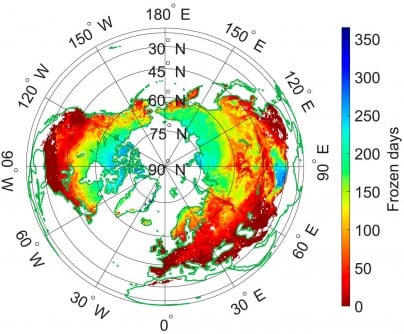Science
Researchers Enhance Soil Monitoring with New Dynamic Algorithm

Recent advancements in soil monitoring techniques have emerged from a collaborative research effort involving scientists from Fudan University, the University of Twente, and Chengdu University of Information Technology. They have developed a new dynamic parameter optimization algorithm aimed at improving the detection of soil freeze-thaw (FT) transitions from space using L-band microwave remote sensing. The study, published on September 10, 2025, in the Journal of Remote Sensing, addresses critical challenges in accurately capturing the freeze-thaw cycles that significantly impact global weather patterns and hydrological processes.
Soil FT transitions influence surface properties such as albedo, moisture, and heat fluxes, which are vital for understanding climate dynamics. Traditional models often overlook essential factors like diurnal temperature variations and surface heterogeneity, which can lead to inaccuracies in large-scale assessments. The researchers identified the limitations of existing algorithms, particularly those based on the Soil Moisture Active Passive (SMAP) satellite data, which depend on fixed parameters that may not be suitable for varying land cover and climatic conditions.
To overcome these limitations, the team introduced an innovative framework that includes three dynamically optimized parameters—α, β, and γ. These parameters represent the detection period, variance window, and threshold sensitivity, respectively. By applying a method similar to maximum likelihood estimation, the algorithm enhances overall classification accuracy across diverse regions.
The optimized algorithm demonstrated substantial improvements in identifying freezing and thawing states by analyzing annual variations in L-band brightness temperature. Results indicated that areas achieving an overall accuracy (OA) greater than 0.7 increased from 54.43% to 89.36%, with notable success in the Qinghai–Tibet Plateau, southwestern Eurasia, and southern North America. Additionally, the new model aligned closely with the ERA5-Land dataset at 81.28% and the SMAP-FT dataset at 79.54%.
Validation of the research findings involved data from 828 in situ soil temperature stations. This process confirmed the algorithm’s superior accuracy and stability, achieving a median accuracy of 0.92, which outperformed both fixed-parameter models and existing SMAP products.
Dr. Shaoning Lv, the corresponding author of the study, highlighted the significance of this research: “The dynamic parameter optimization significantly enhances our ability to capture subtle soil freeze-thaw transitions that vary across regions and seasons. By reflecting diurnal surface changes in real time, our method not only refines the retrieval accuracy of L-band data but also provides a more physically consistent understanding of land-atmosphere interactions.”
The enhanced Diurnal Amplitude Variation–based Freeze–Thaw (DAV-FT) algorithm offers a robust framework for continuous soil freeze-thaw monitoring across diverse terrains. Its ability to consider diurnal temperature cycles and regional variations makes it particularly valuable for high-latitude and mountainous regions, where current algorithms struggle to deliver reliable results.
This advancement in soil state detection is crucial for understanding permafrost dynamics, water availability, and land-atmosphere energy fluxes. These factors are essential for predicting climate change impacts and improving global land-surface models, paving the way for better climate monitoring and agricultural management strategies.
The research received funding from various sources, including the National Key R&D Program of China and the National Natural Science Foundation of China, demonstrating a strong commitment to advancing climate science and remote sensing technologies.
The findings from this study not only contribute to scientific knowledge but also enhance practical applications, reinforcing the importance of innovative approaches in addressing global environmental challenges.
-

 Health4 days ago
Health4 days agoRare Brain Condition Discovered More Common in New Mexico
-

 Politics5 days ago
Politics5 days agoPrince Andrew Steps Back from Royal Duties Following Epstein Memoir
-

 Health5 days ago
Health5 days agoRemembering Mary Ingleby: A Life of Love, Teaching, and Music
-

 Sports5 days ago
Sports5 days agoMLS Decision Day 2025: Playoff Spots on the Line as Teams Clash
-

 Science5 days ago
Science5 days agoIdaho State University Launches Haunted Science Laboratory on Oct. 25
-

 World5 days ago
World5 days agoYoung Driver Dies in Collision with Box Truck in El Cajon
-

 Lifestyle5 days ago
Lifestyle5 days agoKent Hamilton Named Southeastern Farmer of the Year at Expo
-

 Business5 days ago
Business5 days agoFirst National Bank of Groton’s Quiet Period Ends October 21
-

 Entertainment5 days ago
Entertainment5 days agoTrump Commutes George Santos’ Sentence, Sparks Controversy
-

 Politics5 days ago
Politics5 days agoNavy Veteran Max Quattromani Launches Campaign for Assessor Seat
-

 Sports5 days ago
Sports5 days agoSaquon Barkley Reacts to James Franklin’s Dismissal from Penn State
-

 World5 days ago
World5 days agoNevada Treasury Awards 2025 Kenny C. Guinn Memorial Scholarships









